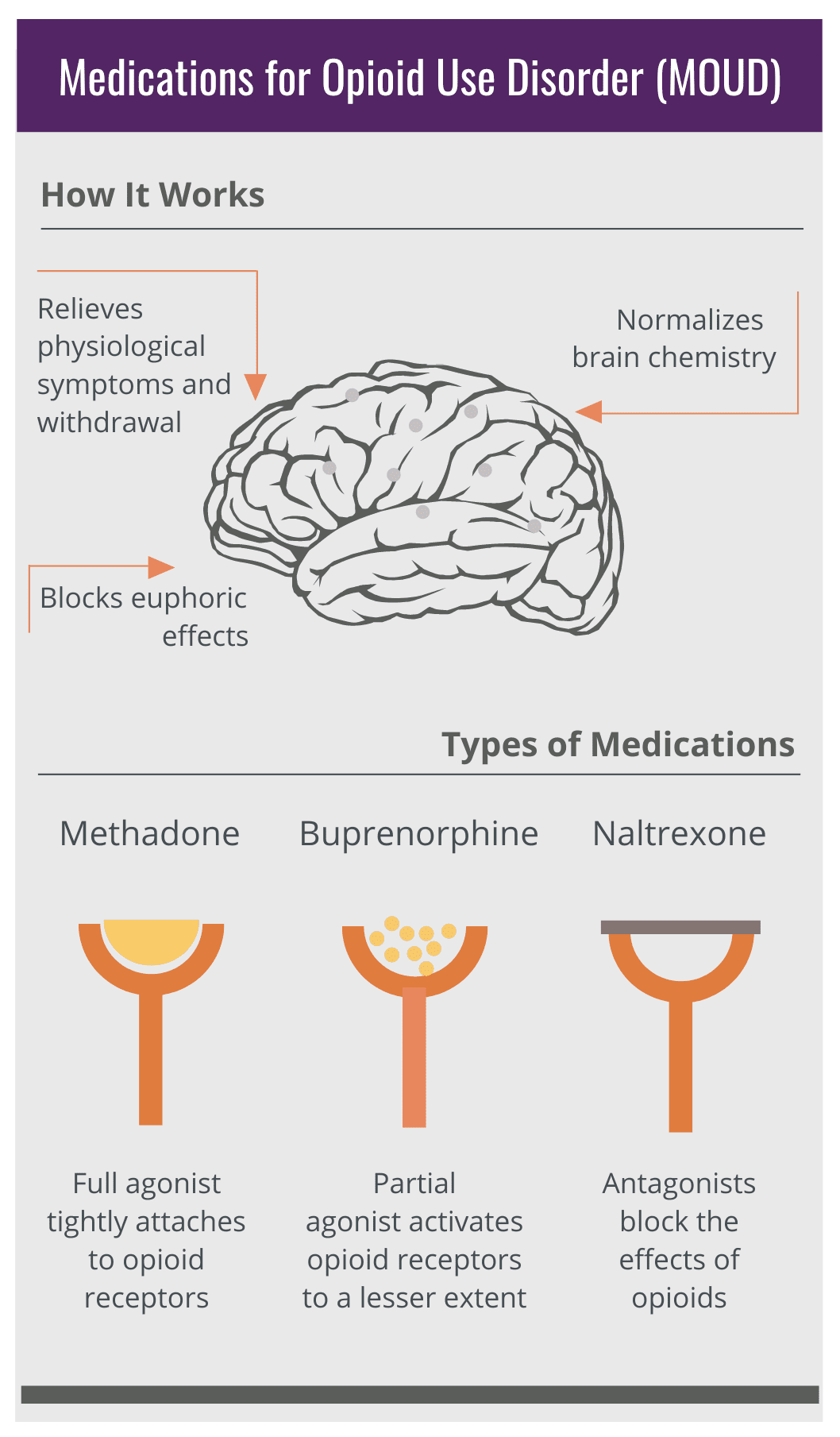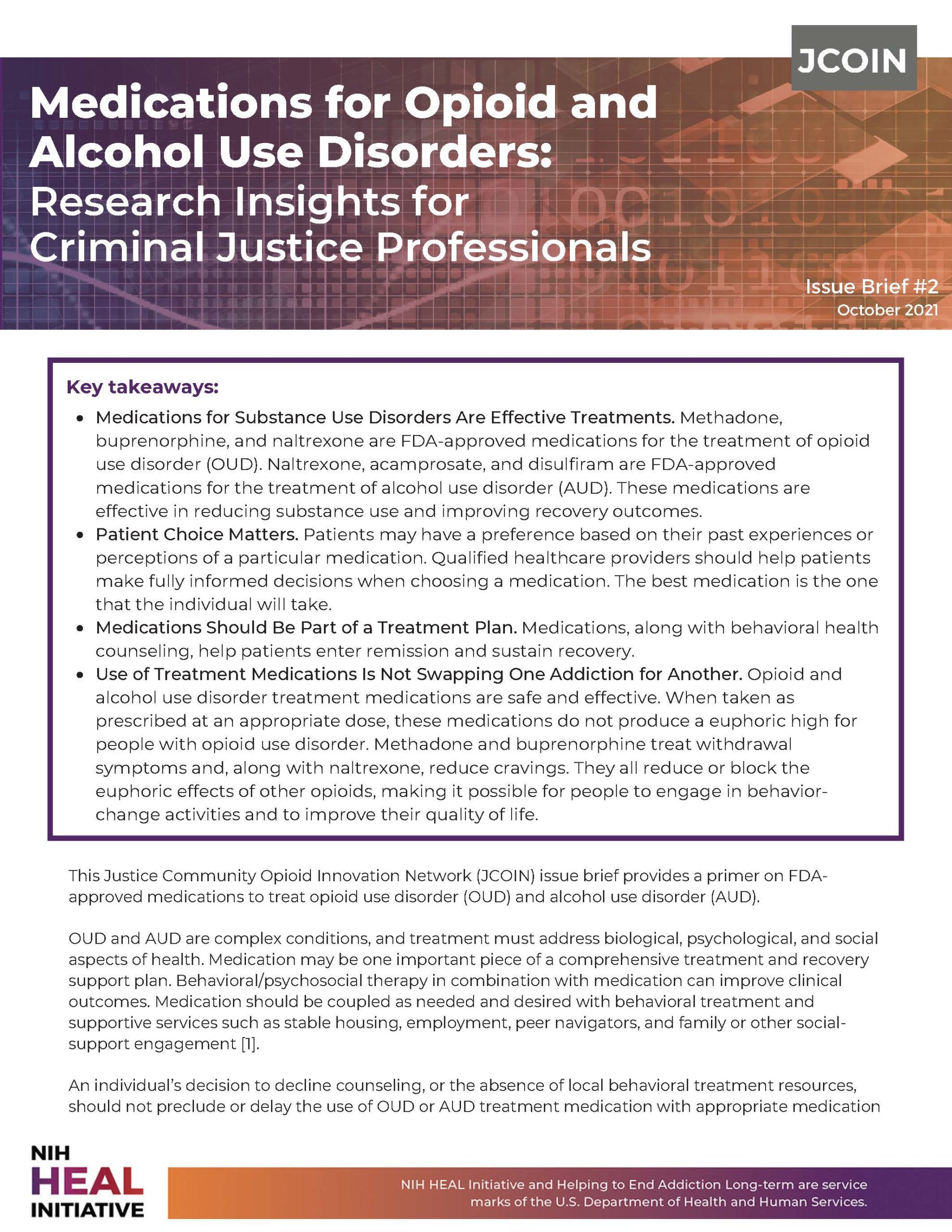Issue Brief: Medications for Opioid and Alcohol Use Disorders: Research Insights for Criminal Justice Professionals
Key Takeaways
This Justice Community Opioid Innovation Network (JCOIN) issue brief provides a primer on FDA- approved medications to treat opioid use disorder (OUD) and alcohol use disorder (AUD).
OUD and AUD are complex conditions, and treatment must address biological, psychological, and social aspects of health. Medication may be one important piece of a comprehensive treatment and recovery support plan. Behavioral/psychosocial therapy in combination with medication can improve clinical outcomes. Medication should be coupled as needed and desired with behavioral treatment and supportive services such as stable housing, employment, peer navigators, and family or other social-support engagement [1].
An individual’s decision to decline counseling, or the absence of local behavioral treatment resources, should not preclude or delay the use of OUD or AUD treatment medication with appropriate medication management [2]. Buprenorphine and methadone have been shown to meaningfully reduce the risk of death, as well as decrease illicit opioid use, overdose, and serious opioid-related acute care [3]. Likewise, persons using opioids along with alcohol and other drugs (including cocaine and methamphetamine) can still benefit from medications for OUD and AUD, and these treatments can help reduce other polysubstance use.
Because methadone and buprenorphine are themselves opioids, some people have incorrectly asserted that the use of these medications is replacing one addiction with another. This misperception hinders the adoption of effective treatment options. Methadone and buprenorphine treat opioid withdrawal symptoms and pain. All three FDA-approved medications for OUD (methadone, buprenorphine, and naltrexone) reduce cravings and reduce or block the euphoric effects of illicit opioids. These treatments make it possible for people to engage in behavior-change activities and to function normally by participating in work, school, and other productive, prosocial life activities [4].
How These Medications Work

Source: Addiction Policy Forum Infographic [5]
Most of the medications for OUD and AUD work by binding to specific receptors in the brain. Receptors are part of the central nervous system. Different receptors react to different kinds of stimuli, such as temperature, pressure, light, or chemicals.
Methadone, buprenorphine, and naltrexone bind to opioid receptors. Depending on how they bind to receptors and the effect they cause, medications for opioid use disorder are classified as an agonist (methadone), partial agonist (buprenorphine), or antagonist (naltrexone). An agonist is a drug that binds to and activates certain receptors in the body. Opioid agonists work by acting on opioid receptors in the brain. A partial agonist is a drug that binds to and activates certain receptors, but to a lesser extent than full agonists. Partial opioid agonists work by acting on opioid receptors in the brain but activate them less strongly than full agonists. An antagonist is a drug that binds to certain receptors without activating them.
Opioid antagonists work by blocking the activation of opioid receptors.
Alcohol stimulates different receptors, called GABA receptors, in the brain. Though naltrexone binds to the opioid receptor, and not to the GABA receptor, it can help reduce cravings and alcohol intake in treatment of AUD, probably because of the critical role of the opioid receptor in the brain’s reward system.
Acamprosate binds to different receptors in the brain. Although the precise mechanisms of action of acamprosate are not yet known, it appears to help in the modulation of a neurotransmitter system that is affected by alcohol consumption.
Unlike the other medications discussed here, disulfiram does not directly affect receptors in the brain. Instead, it blocks enzymes that the body uses to break down alcohol.
It should be noted that none of the AUD medications treat the symptoms of acute alcohol withdrawal, which can be severe, life threatening, and may require hospitalization.
Medications for Opioid Use Disorder
Medications for opioid use disorder (particularly methadone and buprenorphine) have been proven to help reduce opioid use and opioid use disorder-related symptoms, the risk of infectious disease transmission, and criminal behavior associated with drug use. These medications increase the likelihood that a person will remain in treatment. They also mitigate the risks of overdose and death, particularly when used with a comprehensive treatment and recovery support plan [6,7,8,9].
A Note on Naloxone
Naloxone is not used to treat opioid use disorder, but it is critical as an emergency medication to prevent death from overdose. It is an FDA-approved medication to quickly reverse opioid overdose. Naloxone is commonly found under the brand name Narcan.
Medications for Alcohol Use Disorder
Medications to treat alcohol use disorder (naltrexone, acamprosate, and disulfiram) have been proven to help reduce alcohol consumption [13,14]. None of the medications summarized here are treatments for acute alcohol withdrawal, which may be severe, life-threatening, and require emergency room or inpatient care.
Glossary
Medications for Addiction Treatment (MAT): MAT refers to addiction treatment involving the use of FDA-approved medications. MAT is sometimes used as an abbreviation for “medication-assisted treatment”; however, this term reinforces the misconception that counseling alone is a treatment and medication only “assists” the counseling; this can worsen stigma around opioid use [15]. Medications are treatment. Many health conditions (hypertension, diabetes) are treated with medications, without using the word “assisted.”
Medications for Opioid Use Disorder (MOUD): MOUD refers to FDA-approved medications that are used to treat opioid use disorder.
Agonist: An agonist is a drug that binds to and activates certain receptors in the body. Opioid agonists work by acting on opioid receptors in the brain. Methadone is an opioid agonist.
Partial Agonist: A partial agonist is a drug that binds to and activates certain receptors, but to a lesser extent than full agonists. Partial opioid agonists work by acting on opioid receptors in the brain but activate them less strongly than full agonists. Buprenorphine is a partial opioid agonist.
Antagonist: An antagonist is a drug that binds to certain receptors without activating them. Opioid antagonists work by blocking the activation of opioid receptors. Naltrexone and naloxone are opioid antagonists.
For More Information
National Institute on Alcohol Abuse and Alcoholism (NIAAA): Treatment for alcohol problems: Finding and getting help
National Institute on Drug Abuse (NIDA): Effective treatments for opioid addiction
National Institute on Drug Abuse (NIDA): Treating opioid addiction in criminal justice settings
National Institute on Drug Abuse (NIDA): Treatment approaches for drug addiction
Substance Abuse and Mental Health Services Administration (SAMHSA): Use of medication-assisted treatment for opioid use disorder in criminal justice settings
Substance Abuse and Mental Health Services Administration (SAMHSA). Medication for the treatment of alcohol use disorder: A brief guide
References
[1] Hamilton, L., & Belenko, S. (2015). Effects of pre-release services on access to behavioral health treatment after release from prison. Justice Quarterly, 33(6), 1080–1102. https://doi.org/10.1080/07418825.2015.1073771
[2] American Society of Addiction Medicine. (2020). National practice guideline for the treatment of opioid use disorder: 2020 focused update. Journal of Addiction Medicine, 14(2S), 1–91. https://doi.org/10.1097/adm.0000000000000633
[3] Wakeman, S. E., Larochelle, M. R., Ameli, O., Chaisson, C. E., McPheeters, J. T., Crown, W. H., Azocar, F., & Sanghavi, D. M. (2020). Comparative effectiveness of different treatment pathways for opioid use disorder. JAMA Network Open, 3(2). https://doi.org/10.1001/jamanetworkopen.2019.20622
[4] National Institute on Drug Abuse. (2021, June). What are misconceptions about maintenance treatment? https://www.drugabuse.gov/publications/research-reports/medications-to-treat-opioid-addiction/what-are-misconceptions-about-maintenance-treatment
[5] Addiction Policy Forum. (2020). How the medications work to treat opioid use disorder [Infographic]. Navigating addiction and treatment: A guide for families. https://www.addictionpolicy.org/post/navigating-treatment-and-addiction-a-guide-for-families
[6] National Institute on Drug Abuse. (2018, June). How effective are medications to treat opioid use disorder? https://www.drugabuse.gov/publications/research-reports/medications-to-treat-opioid-addiction/efficacy-medications-opioid-use-disorder
[7] National Institute on Drug Abuse. (2018, June). How is opioid use disorder treated in the criminal justice system? https://www.drugabuse.gov/publications/research-reports/medications-to-treat-opioid-addiction/how-opioid-use-disorder-treated-in-criminal-justice-system
[8] Substance Abuse and Mental Health Service Administration. (2019). Use of medication-assisted treatment for opioid use disorder in criminal justice settings. U.S. Department of Health and Human Services. https://store.samhsa.gov/sites/default/files/d7/priv/pep19-matusecjs.pdf
[9] National Commission on Correctional Health Care. (2016, October 23). Substance use disorder treatment for adults and adolescents. https://www.ncchc.org/substance-use-disorder-treatment-for-adults-and-adolescents
[10] Substance Abuse and Mental Health Service Administration. (2021, August 27). Coronavirus (COVID-19): Guidance for OTPs. https://www.samhsa.gov/coronavirus
[11] Minozzi, S., Amato, L., Vecchi, S., Davoli, M., Kirchmayer, U., & Verster, A. (2011). Oral naltrexone maintenance treatment for opioid dependence. Cochrane database of systematic reviews, 2011(4), CD001333. https://doi.org/10.1002/14651858.CD001333.pub4
[12] National Academies of Sciences, Engineering, and Medicine; Health and Medicine Division; Board on Health Sciences Policy; Committee on Medication-Assisted Treatment for Opioid Use Disorder, Mancher, M., & Leshner, A. I. (Eds.). (2019). Medications for Opioid Use Disorder Save Lives. National Academies Press (US). https://www.ncbi.nlm.nih.gov/books/NBK541393/
[13] National Institute on Alcohol Abuse and Alcoholism. (2021, March). Treatment for alcohol problems: Finding and getting help. U.S. Department of Health and Human Services, National Institutes of Health. https://www.niaaa.nih.gov/publications/brochures-and-fact-sheets/treatment-alcohol-problems-finding-and-getting-help
[14] Substance Abuse and Mental Health Services Administration & National Institute on Alcohol Abuse and Alcoholism. (2015). Medication for the treatment of alcohol use disorder: A brief guide. U.S. Department of Health and Human Services. https://store.samhsa.gov/product/Medication-for-the-Treatment-of-Alcohol-Use-Disorder-A-Brief-Guide/SMA15-4907
[15] American Psychological Association. (2019, June). How to talk about addiction. Monitor on Psychology, 50(6). http://www.apa.org/monitor/2019/06/cover-opioids-talk-sidebar
This Issue Brief was developed by TASC in conjunction with JCOIN’s Medications for Opioid Use Disorder Workgroup. This activity was funded under a subcontract to the JCOIN Coordination and Translation Center (U2CDA050097). JCOIN is funded by the National Institute on Drug Abuse as part of the NIH HEAL Initiative. The contents of this publication are solely the responsibility of the authors and do not necessarily represent the official views of the NIH, the NIH HEAL Initiative, or the participating sites.
Suggested citation: Rodriguez, P., Charlier, J., Baille, D., Baumgartner, L., Whitney, T., and the JCOIN MOUD Workgroup. (2021). Medications for Opioid and Alcohol Use Disorders: Research Insights for Criminal Justice Professionals [JCOIN Issue Brief #2]. https://www.jcoinctc.org/issue-brief-medications-for-opioid-and-alcohol-use-disorders/
